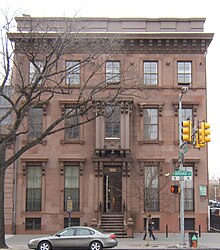Philadelphia School of Design for Women

The Philadelphia School of Design for Women was an art school for women in Philadelphia ( Pennsylvania ) and the largest art school in the country. It is now part of the Moore College of Art and Design .
history
Sarah Anne Worthington King Peter , wife of the British Consul in Philadelphia, William Peter († 1853), founded a commercial arts academy in her home in 1848 to teach a craft to women who had no prospect of support. There she taught lithography , wood carving and design. Household items such as carpets and wallpaper were designed in this context. Her husband passed away shortly after she started the school. Then she returned to Cincinnati ( Ohio back).
In 1850, she wrote to the Franklin Institute regarding her drawing class of about 20 young women to make it a cooperative but separate branch of the institute. The Franklin Institute founded the Philadelphia School of Design for Women in 1850 and ran it until 1853. A group of 17 men were appointed in 1853 to head the school. Elliott Cresson was one of those 17 directors and was elected President at the first meeting. It was the largest art academy for women in the country. The students included Emily Sartain and Jessie Willcox Smith .
Elizabeth Croasdale was the headmistress of the school before Emily Sartain took over from her in 1886. Sartain held the post until 1920. During her tenure, she implemented Life Drawing Classes . For this she used draped male and naked female models, which was revolutionary for women artists at the time. Sartain created a professional program, which was based on technical and lengthy training and high standards. She taught women to create works of art based on three-dimensional and human forms, which was the basis of her training in Paris and the Pennsylvania Academy of the Fine Arts . She was responsible for admitting key faculty members such as Robert Henri , Samuel Murray, and Daniel Garber . In 1892 Robert Henri began teaching at the school. William Innes Homer later said the following:
"A born teacher, Henri enjoyed immediate success at the school."
Nina de Angeli Walls wrote the following:
"As Sartain's career illustrates, art schools conferred professional status in a cultural field once dominated by men. Women artists used formal schooling to counter the accusation of amateurism frequently leveled at them. Nineteenth century design schools were the first institutions to offer professional certification for women in such careers as art education, fabric design, or magazine illustration; hence, the schools opened unprecedented paths to female economic independence. "
In 1932 the school was merged with the Moore Institute of Art, Science and Industry . The resulting Moore College of Art and Design now offers a Bachelor of Fine Arts and a Master of Arts in Art Education, among other things.
Faculty (selection)
Female students (selection)
- Elenore Abbott
- Theresa Bernstein
- Mary-Russell Ferrell Colton
- Florence Esté
- Lillian Genth
- Bessie Pease Gutmann
- Charlotte Harding
- Ella Sophonisba Hergesheimer
- Alice Neel
- Anne Parrish
- Deborah Griscom Passmore
- Katharine Pyle
- Paulette Van Roekens
- Jessie Willcox Smith
- Alice Barber Stephens
- Louise E. Baker
Individual evidence
- ^ A b c d Tinling, Marion: Women Remembered: A Guide to Landmarks of Women's History in the United States, New York: Greenwood Press, 1986, p. 445
- ^ The Elliott Cresson Medal - Founded in 1848 - Gold Medal
- ^ A b Eisenmann, Linda: Historical Dictionary of Women's Education in the United States, (Nina de Angeli Walls: Design school movement ) Westport, Connecticut: Greenwood Press, 1998, pp. 129f
- ↑ Elizabeth Johns, Katharine Martinez and Page Talbott: Philadelphia's Cultural Landscape , Temple University Press, 2000, ISBN 9781566397919 , p. 144
- ↑ Elizabeth Johns, Katharine Martinez and Page Talbott: Philadelphia's Cultural Landscape , Temple University Press, 2000, ISBN 9781566397919 , p. 139
- ^ A b Nina de Angeli Walls: Art, Industry, and Women's Education in Philadelphia, Bergin & Garvey, 2001, ISBN 0-89789-745-5
- ^ William Innes Homer: Robert Henri and his Circle, Ithaca: Cornell University Press, 1969, ISBN 0-87817-326-9 , p. 71